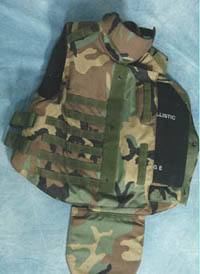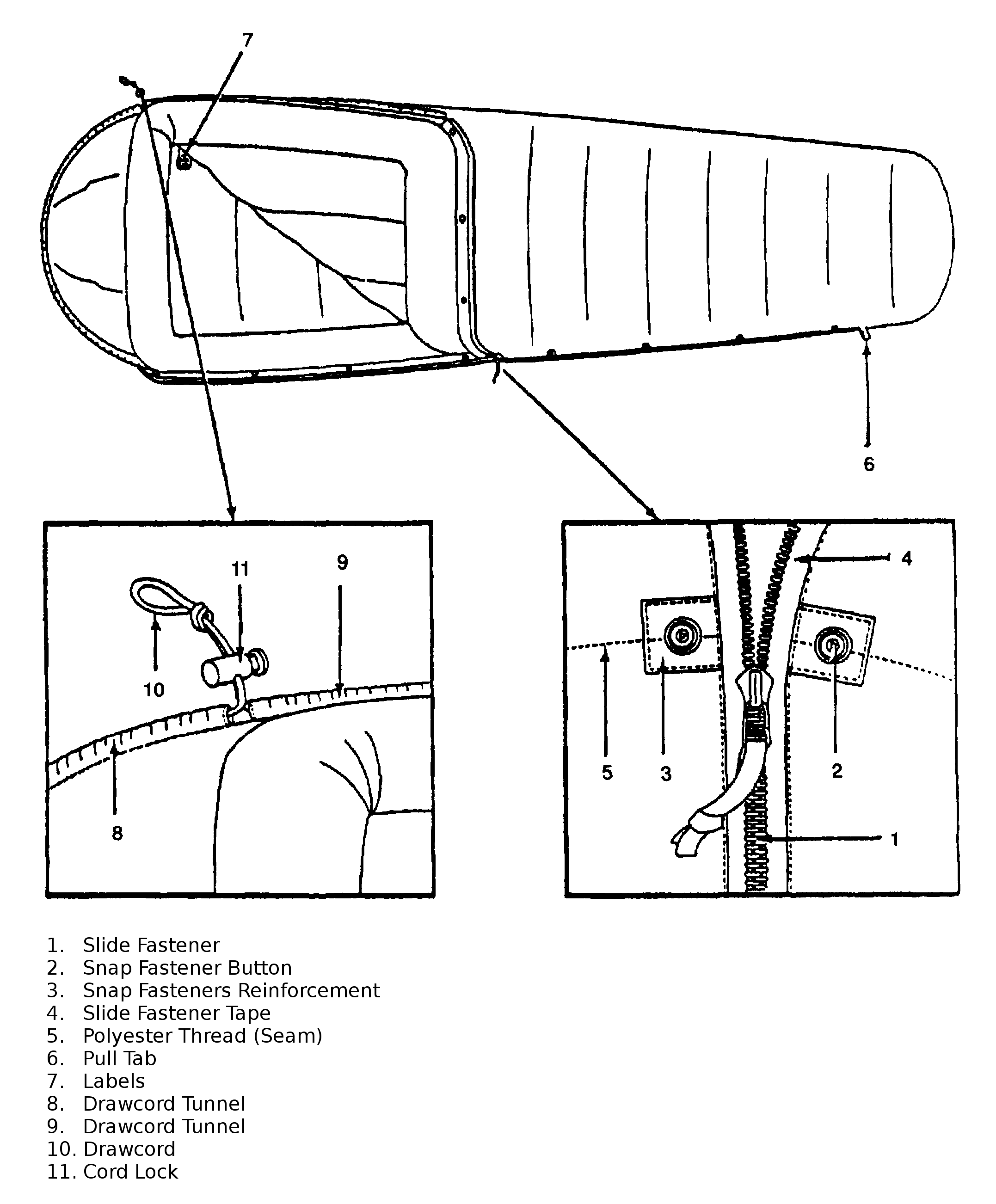Cold Temperature and Arctic Protection Systems
Cold Temperature and Artic Protective System (CTAPS) is a soldier head to toe clothing ensemble with -65 to +45°F environmental protection.
Extended Cold Weather Clothing System

The Extended Cold Weather Clothing System (ECWCS) is a layered insulating system adjustable to personal preference, metabolism, and prevailing weather conditions.It is designed to maintain adequate environmental protection between +40°F and -60°F (4°C and -51°C).
Lightweight Environmental Protection

The Lightweight Environmental Protection (LEP) is an insulation subsystem developed under the Special Operations Forces Personal Equipment Advanced Requirements (SPEAR).The system is designed to be individually configured based upon mission, terrain and climate requirements as well as personal preference.
Mountain/Cold Weather Clothing System

The Mountain/Cold Weather Clothing System (MCWCS) is a Marine Corps specific cold weather layering system (CWLS), a replacement for the ECWCS.
Protective Combat Uniform

The Protective Combat Uniform (PCU) is an interchangeable 15-piece, 7-level ensemble (the original block 0 configuration) that can be worn in layers appropriate for the mission.The PCU replaces the LEP.
Marine Corps Cold Weather Wear Guidance
Wear guidance for cold weather clothing fielded by the Program Manager, Infantry Combat Equipment, Marine Corps Systems Command (PM ICE, MARCORSYSCOM).
Generation III Extended Cold Weather Clothing System

The Generation III Extended Cold Weather Clothing System (GEN III ECWCS) was designed to be functional in multiple cold weather climates and activities.It consists of a versatile, multi-layered insulating system that allows the Soldier to adapt to varying mission requirements and environmental conditions.
Cold-Wet/Cold-Dry Clothing System

The combination Cold-Wet/Cold-Dry Clothing System (M-1951) can be configured into two ensembles. The cold-wet ensemble is worn above 14°F, and the cold-dry ensemble is worn below 14°F. The cold-dry ensemble protects down to -60°F. The cold-wet configuration differs from the cold-dry in the number of layers and the choice of boots. The system uses layers of wool/cotton fabrics to trap air for insulation, and a water-repellent outer garment to maintain dryness.
Cold-Wet/Cold-Dry Clothing System

The combination Cold-Wet/Cold-Dry Clothing System (M-65) can be configured into two ensembles. The cold-wet ensemble is worn above 14°F (-10°C), and the cold-dry ensemble is worn below 14°F. The cold-dry ensemble protects down to -60°F (-51°C). The cold-wet configuration differs from the cold-dry in the number of layers and the choice of boots. The system uses layers of wool/cotton fabrics to trap air for insulation, and a water-repellent outer garment to maintain dryness.
Fire Resistant Environmental Ensemble

The Fire Resistant Environmental Ensemble (FREE) is a multilayered, versatile, flame resistant system.Its unique individual layers are adaptable into multiple system configurations.This flexibility allows the Soldier greater uniform/personal protection choices.These choices are critical in responding to the current engagement threats while facing extreme climate conditions.
Flame Resistant Organizational Gear

Due to the threat of burn injuries stemming from OIF/OEF, a USON was established that required burn protection for the hands and face/neck. After extensive testing, it was determined that in addition to providing base layer of flame/fire protection, an outer layer of protection is essential.
All-purpose Lightweight Individual Carrying Equipment

The All-purpose Lightweight Individual Carrying Equipment (ALICE) was adopted as Standard A on 17 January 1973 to replace M-1956 and M-1967 systems.
Body Armor/Load Carriage System

The SPEAR Body Armor/Load Carriage System (BALCS) consists of body armor, an equipment load carrying subsystem, and a backpack subsystem.
Marine Corps Close Quarters Battle Equipment
The Marine Corps Close Quarters Battle Equipment (CQBE) consists of the assault suit, assault vest system, individual assault kit, assault gas mask, assault breacher kit, and assault breacher torch kit.
Family of Improved Load Bearing Equipment

Family of Improved Load Bearing Equipment (FILBE) utilized by the United States Marine Corps is designed to allow Marines to carry equipment needed in support of combat operations. The load bearing erquipment system is modular in order to meet the unique needs of the warfighter. The system will maximize the ability to carry combat loads efficiently, minimize the burdens of weight, improve overall system compatibility and increase the combat effectiveness of the user.
Full Spectrum Battle Equipment

Full Spectrum Battle Equipment (FSBE) reduces the component weight, provides a single point of release mechanism, and has an integrated breathing and flotation system. FSBE replaces the Close Quarters Battle Equipment (CQBE) Assault Vest System (AVS).
Integrated Individual Fighting System
In 1988, the Integrated Individual Fighting System (IIFS) was adopted by the Army. The design was based on commercial backpacks modified for military use with the addition of a special fighting vest and a detachable patrol pack. The original focus was to develop a load-carrying system for use in cold weather. However, in the final analysis, the Army selected the new internal frame system as a replacement for the external framed All-purpose Lightweight Individual Carrying Equipment system.
Individual Load Carrying Equipment (M1956)

The individual load carrying equipment (ILCE) is intended for use in hot, temperate, and cold-wet regions of the world. It is not for use in cold-dry arctic regions.
Lightweight Load Carrying Equipment (M1967)

Components of the Lightweight Load-Carrying Equipment are similar in design to components of the standard M1956 individual load-carrying equipment.Because nylon materials and aluminium hardware are lightweight, they are used where possible in lieu of cotton materials and brass or steel hardware.The nylon materials are water resistant, retain less moisture and dry faster.
Modular Lightweight Load-carrying Equipment

The Modular Lightweight Load-carrying Equipment (MOLLE) was designed to replace the All-purpose Lightweight Individual Carrying Equipment (ALICE) and Integrated Individual Fighting System (IIFS) including the Enhanced Tactical Load-Bearing Vest.
Modular Lightweight Load-carrying Equipment II

Based on user feedback on the original system, the MOLLE requirements were modified to eliminate the need for a quick-release frame that integrates into the load bearing vest (LBV).The change allowed developers to replace the probe and socket mechanism, which caused problems in donning for some soldiers and Marines, to a quick-release mechanism for a more traditional permanently-mounted waist belt on the frame.
Interceptor Body Armor

The Interceptor Body Armor (IBA) was designed to replace the Personnel Armor System Ground Troops (PASGT) vest and the Interim Small Arms Protective Overvest (ISAPO).
Personnel Armor System for Ground Troops

Personnel Armor System for Ground Troops (PASGT) was originally type-classified in the late 1970's and first fielded in early 1980's.
3 Season Sleep System

The 3 season sleep system (3S) is a single sleeping bag system that is lighter in weight and provides increased environmental protection for all environments except extreme cold weather.
Extreme Cold Weather Sleeping System

The Extreme Cold Weather Sleep System (ECWSS) will provide environmental protection between +40°F and -45°F (+5°C and -46°C) and is intended to be used with the foam sleeping mat.
Intermediate Cold Weather Sleeping System

The Intermediate Cold Weather Sleeping System is an ICW version of the extreme cold weather sleeping system.
Modular Sleep System

The Modular Sleep System is designed to insulate the user in environments ranging from mild weather to extreme cold weather.
A-A-55262: SLEEPING BAG, MODULAR
Commercial item description A-A-55262 covers a modular sleeping bag system that consists of a patrol sleeping bag, an intermediate cold weather sleeping bag and a compression stuff sack to carry the complete system.
MIL-S-44361: SLEEPING BAG SYSTEM, FOR EXTREME COLD WEATHER
Military specification MIL-S-44361 covers a complete extreme cold weather sleeping bag system.
MIL-S-44429: SLEEPING BAG SYSTEM, FOR INTERMEDIATE COLD WEATHER
Military specification MIL-S-44429 covers a complete intermediate cold weather sleeping bag system.
CO/PD 00-02: BODY ARMOR, MULTIPLE THREAT / INTERCEPTOR
Purchase description CO/PD 00-02 provides for a multiple threat/Interceptor body armor system (IBA) consisting of a base vest and modular components (OTV) for tailoring protection levels to defeatmultiple ballistic hazards across the battlefield continuum and manage armor weight.
CO/PD 02-02: MODULAR LIGHTWEIGHT LOAD-CARRYING EQUIPMENT (MOLLE)
Purchase description CO/PD 02-02 covers the Modular Lightweight Load-carrying Equipment.
GL/PD 07-09: SLEEPING BAG SYSTEM, MODULAR
Purchase description GL/PD 07-09 covers a modular sleeping bag system that consists of a patrol sleeping bag, an intermediate cold weather sleeping bag, a waterproof bivy cover and two compression stuff sack to carry the components of the system.
PURCHASE DESCRIPTION: FAMILY OF IMPROVED LOAD BEARING EQUIPMENT
This purchase description covers the Family of Improved Load Bearing Equipment utilized by the United States Marine Corps.